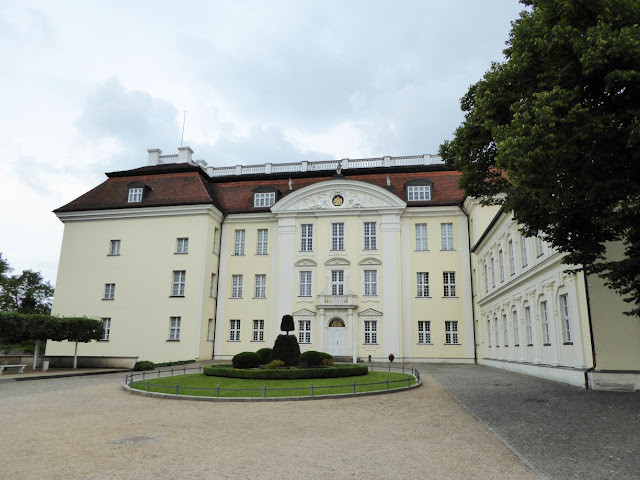It is with a certain amount of dread that I walk down the steps to the Keller. Have they have fucked it up?
Luckily, they haven’t. Little has changed from my memories, other than a coat of paint and a new bar counter. Still looks pretty classy. Much classier than the prices.
There’s a smattering of other diners, but not too many. It is after 2 PM, so not that surprising. We grab a table for two next a long and very nicely laid out one. Very posh.
It’s been at least 10 minutes since my last beer. Best order something quickly. Oh look, they’ve got Köstritzer Schwarzbier on draught. Not had a pint of that for ages. That’ll do nicely. Dolores opts for a Wernesgrüner Pils. I’m impressed by how DDR the beer selection is. They may well have sold Wernesgrüner in the old days, it being fairly posh here back then, too. Can’t say I was ever that impressed with the stuff myself or Radeberger. I much preferred the Pilseners of Thüringen.
We’re only after something light. Dolores opts for one of her favourite things: raw minced pork.
“Not much cooking for the chef to do there.” I quip.
Did I mention that Dolores’s paternal grandmother was from East Prussia? Dolores’s paternal grandmother came from East Prussia. Which is why Dolores knows how to make Königsberger Klopse, a type of boiled meatball. After I order a portion, I realise I’ve a bit of a Kö- theme going on: Ratskeller Köpenick, Köstritzer Schwarzbier, Königsberger Klopse.
We’re halfway through our meal when we realise why the long table looks so posh. A wedding party turns up. It’s slightly odd when the speeches start, as we’re sitting right next to them. Like less fashionable relations at a satellite table.
Did I mention how ridiculously cheap it is? A meal each, 2 pints for me and a pint and a half for Dolores comes to €32.80. A bargain. Especially as it was also really tasty.
All prandialled-up, we set off to stretch our legs a little. Our destination is Schloss Köpenick, a baroque palace. I have vague memories of visiting it last time we were down this way all those years ago. It’s not much of a leg-stretcher, being not much more than 100 metres.
The palace itself doesn’t seem to be open, so we go and sit in the garden. Just as well I’ve my emergency pint with me. I suck on that as we watch another wedding party have their photos taken. I can see why they chose here. It’s a very pretty spot. And a short stroll from the Rathaus where I assume the official formalities took place.
It’s pretty obvious this must have originally been a castle. The centre of Köpenick is on an island and the Schloss is on a smaller island off that. An obvious spot for a settlement and fortification.
When the photographer has done his work and my emergency pint is used up, it’s time to move on. Not to worry. A brewery is just a few steps away. One I’d wanted to visit for a while.
Not just any old brewery. What claims to be the smallest commercial brewery in Germany. I won’t argue with them. Their kettle is tiny. Really tiny. Most serious home brewers have larger kit.
It’s a strange sort of place. Basically a glass cube in the middle of the square. There’s a bit of seating inside, but far more room at outside tables. Which is where me and Dolores park our arses, trying to stay upwind of the smokers. Of which there are plenty.
For a German brewpub, the beer range isn’t bad. Not just the dreaded Helles, Dunkles, Weizen trio, all served very green. I don’t understand how anyone can drink the godawful Helles many brewpubs offer. Here there’s also a Pale Ale a Kirsch-Chilli Bier and, what most impressed me, Köpenicker Moll, a local style.
They say on their website that the recipe was developed from archive material and in collaboration with a historian. But I’ve learnt to be pretty cynical about these things. Without more details about the recipe, it’s hard for me to judge how authentic the beer is.
The beers are pleasant enough. Definitely drinkable, which isn’t always a given. We have a couple before wending our way back to the S-Bahn station.
It’s been a fun day out. Köpenick hasn’t disappointed.
Ratskeller Köpenick,
Alt Köpenick 21,
12555 Berlin.
Tel: + 49 (0)30 6 55 51 78
Fax: +49 (0)30 65 47 27 49
E-Mail: verkauf@ratskeller-koepenick.de
http://www.ratskeller-koepenick.de
Draught beers: Wernesgrüner Pils, Köstritzer Schwarzbier, Erdinger Hefeweizen and Guinness
Schlossplatzbrauerei Köpenick
Grünstraße 24
12555 Berlin- Köpenick
Tel. : 030 42096876
m.rubbert@schlossplatzbrauerei-koepenick.com
http://www.schlossplatzbrauerei-koepenick.com/







































































































